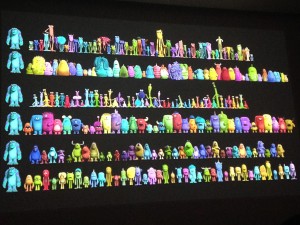
The Stanford Design Initiative (SDI), along with the San Francisco chapter of Women in Animation, co-hosted a panel event in Annenberg Auditorium entitled “Scare School 101” on Monday night, during which the filmmaking team of Pixar Animation Studios guided over 200 attendees through the production process of their movie “Monsters University.”
Panelists included supervising technical director Sanjay Bakshi; technical lighting lead Steven James; lighting technical director Scott Clifford; and animator Allison Rutland.
The event was completely funded by the ASSU. The allocation of 200 free tickets sold out within two hours of their email release.
Bakshi began the talk with a discussion of the major technical challenges encountered during the making of “Monsters University”, including incorporating more characters than ever before and the simulation of furry monsters wearing clothes, as well as lighting and rendering. His presentation included story reels from the film and took attendees through the process of creating character designs.
Rutland followed with a presentation on the animation process.
“We take reality and abstract it to tell a story,” she said, using the character Sulley to give an example of the animation process. Her talk focused on how animators showcased Sulley’s personality and thoughts through the animation of realistic physicality and actions.
James and Clifford concluded the talk by focusing on the film’s complex lighting processes. James discussed the Global Illumination Project, an endeavor designed to add more realistic lighting in three-dimensional animation through global illumination (GI) or physically-based rendering techniques.
James showed scenes from the movie with and without global illumination to highlight the difference created by the technique. Clifford, meanwhile, focused on the urchin lighting setup of a particular scene in the film’s Scare Games sequence, drawing in the technological aspects of developing 3,679 points of light.
“It’s just a for-loop that runs a thousand times,” he remarked about the setup.
The panel ended with a brief Q&A session to address questions that had been pre-submitted by attendees and then approved by SDI. During this period, the filmmaking team discussed their backgrounds in animation, expanded further on animation processes and challenges faced during the making of the film and gave advice to budding designers.
“Animation is so subjective, so show other people your work and get feedback,” Rutland emphasized, encouraging students to find a mentor.
“Be interesting,” Clifford said. “You need something to stand out.”
Overall, student reactions to the event were extremely positive.
During the event, Katie Kirsch ’16 enthusiastically thanked the panelists for the extremely interesting talk. Afterwards, Su Lin Yeo ’15 reflected on what she learned.
“I didn’t know how much work went into the animation process—I always thought animation was just the creative process of developing the storyline,” she said. “It was really interesting to learn that the people who can code and animate did a lot of the hard work. It’s a much more strategic and analytical process than I expected.”
SDI’s main objective for the event was to build a community of creative thinkers, according to SDI co-president Sheta Chatterjee ’14, who believed that the panel was beneficial to the Stanford community.
“A lot of people on campus want to get involved in design-related things, and animation covers many aspects of the creative process,” Chatterjee said, adding that the success of the panel validated SDI’s plans to host similar events and workshops in the future.
Contact Tiffany Lam at tlam28 ‘at’ stanford ‘dot’ edu.